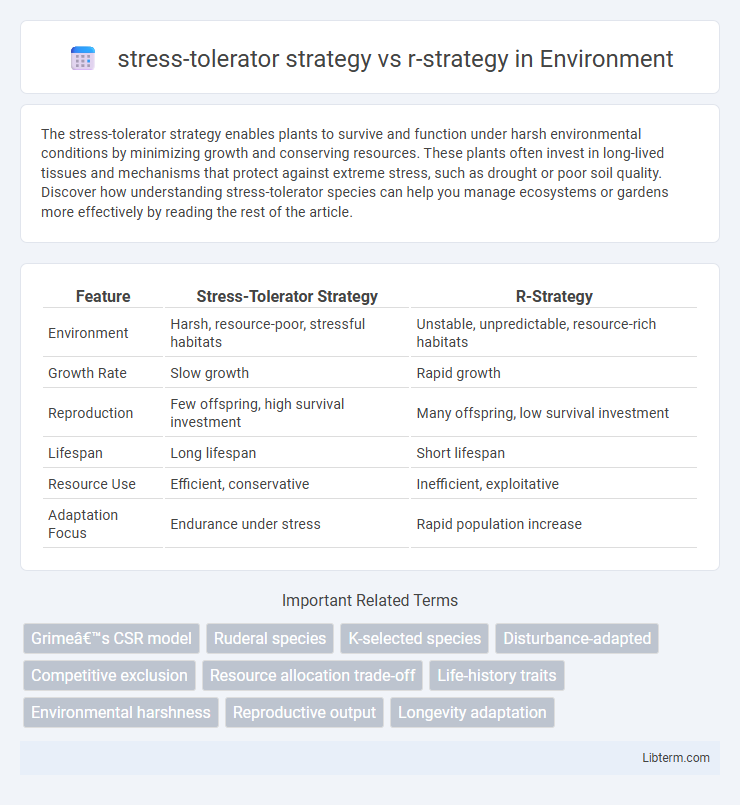The stress-tolerator strategy enables plants to survive and function under harsh environmental conditions by minimizing growth and conserving resources. These plants often invest in long-lived tissues and mechanisms that protect against extreme stress, such as drought or poor soil quality. Discover how understanding stress-tolerator species can help you manage ecosystems or gardens more effectively by reading the rest of the article.
Table of Comparison
| Feature | Stress-Tolerator Strategy | R-Strategy |
|---|---|---|
| Environment | Harsh, resource-poor, stressful habitats | Unstable, unpredictable, resource-rich habitats |
| Growth Rate | Slow growth | Rapid growth |
| Reproduction | Few offspring, high survival investment | Many offspring, low survival investment |
| Lifespan | Long lifespan | Short lifespan |
| Resource Use | Efficient, conservative | Inefficient, exploitative |
| Adaptation Focus | Endurance under stress | Rapid population increase |
Introduction to Plant Survival Strategies
Stress-tolerator strategies in plants emphasize survival under harsh environmental conditions by investing in maintenance and resource conservation, featuring traits like slow growth, long-lived tissues, and efficient nutrient use. In contrast, r-strategy plants prioritize rapid reproduction and colonization in unpredictable or disturbed environments, characterized by fast growth, high seed output, and short lifespans. Understanding these strategies reveals how plant species adapt to varying stresses and resource availability, influencing ecosystem dynamics and biodiversity.
Defining Stress-Tolerator Strategy
Stress-tolerator strategy in ecology refers to organisms adapted to persist in environments with limited resources, slow growth, and high stress factors such as extreme temperatures or low nutrient availability. These species prioritize maintenance and survival over rapid reproduction, often exhibiting traits like low metabolic rates, durable structures, and efficient resource use. In contrast, r-strategy organisms focus on high reproductive rates and rapid colonization of transient or disturbed habitats, sacrificing longevity and stress resistance.
Understanding R-Strategy in Plants
R-strategy in plants emphasizes rapid growth, high reproductive rates, and producing numerous small seeds to maximize colonization in unpredictable or disturbed environments. These species invest energy in seed production over longevity, allowing quick population expansion but often result in shorter lifespans and lower competitive ability. In contrast to stress-tolerators, r-strategists exploit transient resources, prioritizing reproduction over stress endurance or competitive strength.
Key Traits of Stress-Tolerators
Stress-tolerator species exhibit slow growth, low reproductive rates, and high resource conservation, enabling survival in environments with consistent stress such as nutrient-poor soils or extreme climates. Their key traits include efficient resource use, durable tissues, and mechanisms to withstand prolonged adverse conditions. In contrast, r-strategists prioritize rapid reproduction and high dispersal ability but typically lack the resilience traits necessary for enduring sustained environmental stress.
Main Features of R-Strategists
R-strategists exhibit rapid growth, early reproduction, and high fecundity, producing numerous offspring with minimal parental investment. They thrive in unpredictable or disturbed environments where competition is low and mortality rates are high. Their short life cycles and opportunistic behavior enable quick exploitation of transient resources, contrasting with the stress-tolerator strategy that emphasizes survival under adverse conditions.
Environmental Adaptations and Habitat Preferences
Stress-tolerator species exhibit adaptations such as slow growth, resource conservation, and tolerance to harsh environmental conditions like drought, nutrient-poor soils, or extreme temperatures, enabling survival in stable but challenging habitats. In contrast, r-strategy organisms prioritize high reproductive rates, rapid development, and dispersal abilities, thriving in unpredictable environments with frequent disturbances where resource availability fluctuates. Habitat preferences of stress-tolerators include resource-limited ecosystems like deserts or tundra, whereas r-strategists dominate transient, disturbed habitats such as grasslands or disturbed wetlands.
Reproductive Approaches Compared
Stress-tolerator plants reproduce slowly with low seed output, investing resources in survival and longevity under harsh conditions, while r-strategists produce numerous offspring rapidly, maximizing colonization in unpredictable environments. Stress-tolerators often rely on vegetative propagation or delayed seed germination to endure stress, contrasting sharply with r-strategists' high fecundity and short generation times. This reproductive divergence underlines adaptive trade-offs between survival investment and reproductive rate in response to environmental pressures.
Growth Rates and Lifespan Differences
Stress-tolerator strategies are characterized by slow growth rates and long lifespans, enabling organisms to survive in harsh, resource-limited environments by conserving energy and investing in maintenance. In contrast, r-strategists exhibit rapid growth rates and short lifespans, favoring high reproductive output and quick maturation to exploit transient resource availability. These divergent life-history traits reflect adaptations to different ecological pressures, with stress-tolerators prioritizing longevity and efficiency while r-strategists emphasize rapid population expansion.
Ecological Roles and Competitive Advantages
Stress-tolerator species, characterized by slow growth and resource conservation, dominate in environments with chronic stress such as drought or low nutrient availability, ensuring survival through efficient energy use and resistance to damage. In contrast, r-strategy species exhibit rapid reproduction and high dispersal rates, enabling quick colonization of disturbed or transient habitats but often at the cost of competitive ability in stable ecosystems. The competitive advantage of stress-tolerators lies in their resilience and persistence under resource-limited conditions, whereas r-strategists excel in exploiting unpredictable environments by maximizing reproduction and rapid population expansion.
Conclusion: Choosing Survival Paths in Nature
Stress-tolerator strategies prioritize resource efficiency and slow growth to withstand harsh environments, while r-strategies emphasize rapid reproduction and high offspring numbers for quick colonization. These contrasting survival paths reflect adaptations to resource availability and disturbance frequency in ecosystems. Selecting between them depends on environmental stability, where stress-tolerators thrive in constant scarcity and r-strategists succeed in unpredictable or transient habitats.
stress-tolerator strategy Infographic

 libterm.com
libterm.com